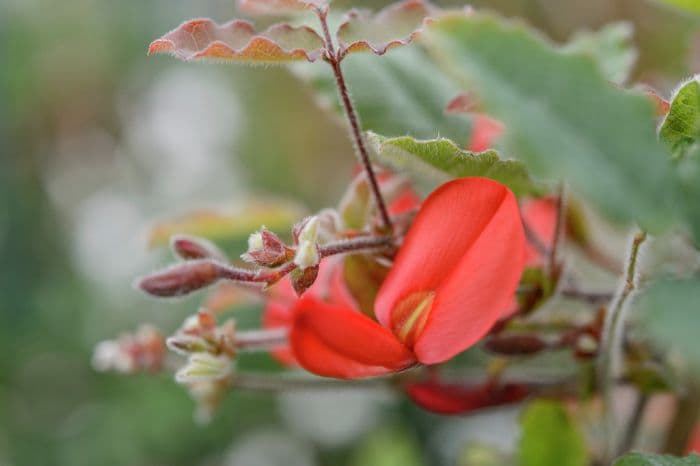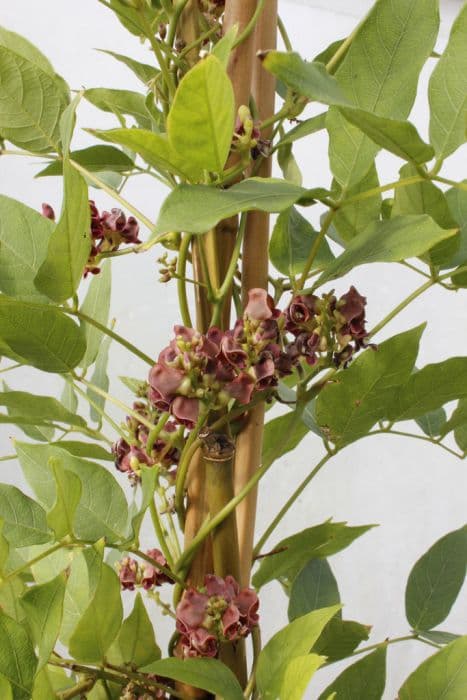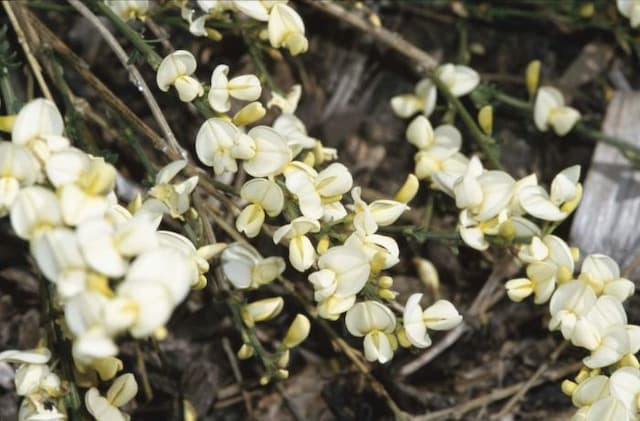Running Postman Kennedia prostrata

ABOUT
The plant known as Running Postman or Scarlet Runner showcases a sprawling growth habit that gracefully covers the ground. It stands out with its vibrant, red pea-shaped flowers that bloom abundantly, providing a striking contrast against its foliage. The leaves of this plant are trifoliate, meaning they are grouped in threes, and exhibit a rich green color that complements the bright blossoms. The plant tends to have a wiry stem structure, supporting its prostrate manner of spreading. The foliage, together with the vivid red flowers, not only adds visual interest but also serves to attract various pollinators, with their color and shape being particularly appealing to birds and bees. The overall appearance of the Running Postman is one of robust natural beauty that can enliven ground spaces with its spreading form and striking floral display.
About this plant
 Names
NamesSynonyms
Running Postman, Scarlet Runner, Kennedia.
Common names
Kennedia prostrata.
 Toxicity
ToxicityTo humans
Running postman (Kennedia prostrata) is not widely regarded as a toxic plant to humans. There is limited information on its toxicity, and it is generally not considered to have poisonous properties that would cause harm if accidentally ingested. However, as with any plant, individual allergic reactions or sensitivities could occur, and it is always advisable to exercise caution and not consume parts of plants that are not traditionally recognized as edible.
To pets
Running postman (Kennedia prostrata) is also not known to be toxic to pets. There is no significant evidence to suggest that it possesses compounds that would be harmful to pets if they were to ingest it. As with human ingestion, there is always a risk of individual allergic reactions or gastrointestinal upset in sensitive animals, so it is best to prevent pets from consuming plants that are not confirmed to be safe for them.
 Characteristics
CharacteristicsLife cycle
Perennials
Foliage type
Evergreen
Color of leaves
Green
Flower color
Red
Height
1 foot (30 cm)
Spread
5 feet (1.5 meters)
Plant type
Creeper
Hardiness zones
9
Native area
Australia
Benefits
 General Benefits
General Benefits- Groundcover: Kennedia prostrata, known as Running Postman, acts as an effective groundcover, spreading across the ground to protect the soil from erosion.
- Nitrogen Fixation: Being a member of the Fabaceae family, it has the ability to fix nitrogen in the soil, thus improving soil fertility.
- Drought Tolerance: Running Postman is drought tolerant once established, making it suitable for low-water gardens and arid climates.
- Erosion Control: The dense mat of foliage and roots helps stabilize the soil, preventing erosion on slopes and embankments.
- Habitat Provision: It provides habitat and shelter for small insects and animals, contributing to biodiversity.
- Low Maintenance: Running Postman requires minimal maintenance, which can be advantageous for large landscaping projects or for gardeners seeking low-effort plants.
- Ornamental Value: The bright red flowers add aesthetic value to gardens and landscapes.
- Fast Growth: This plant has a rapid growth rate, which can be beneficial for quickly establishing a groundcover.
 Medical Properties
Medical PropertiesThis plant is not used for medical purposes.
 Air-purifying Qualities
Air-purifying QualitiesThis plant is not specifically known for air purifying qualities.
 Other Uses
Other Uses- Garden ground cover: Running Postman is often used as a fast-growing ground cover in gardens to suppress weeds and cover bare patches of soil.
- Erosion control: Due to its spreading habit, it can be used to stabilize soil and prevent erosion on slopes and banks.
- Butterfly attraction: The flowers of the Running Postman attract native butterflies and other beneficial insects, making it a valuable addition to a biodiversity-friendly garden.
- Living mulch: The dense mat that Running Postman forms can act as a living mulch, retaining soil moisture and providing habitat for ground-dwelling creatures.
- Educational uses: Running Postman can be used in educational settings such as schools and botanical gardens to teach about native Australian flora and plant adaptation.
- Landscape aesthetics: Its vibrant red flowers can be used to create visually striking contrasts in landscaping designs.
- Nitrogen fixation: Like other leguminous plants, it can fix nitrogen in the soil, effectively fertilizing the soil for other nearby plant species.
- Habitat restoration: Running Postman can be included in revegetation and habitat restoration projects to help reestablish native plant communities.
- Green roofing: Its prostrate growth habit makes it suitable for use in green roof installations where low maintenance and drought tolerance are preferred.
- Fodder for fauna: The plant can offer forage for native fauna, particularly for ground-dwelling species, in a garden ecosystem.
Interesting Facts
 Feng Shui
Feng ShuiThe Running Postman is not used in Feng Shui practice.
 Zodiac Sign Compitability
Zodiac Sign CompitabilityThe Running Postman is not used in astrology practice.
 Plant Symbolism
Plant Symbolism- Adaptability: Kennedia prostrata, commonly known as Running Postman, thrives in a variety of soil types and conditions, symbolizing the ability to adapt and succeed in various environments.
- Resilience: As a hardy plant, it represents resilience, with the capability to withstand challenging conditions and still flourish.
- Connection: The trailing nature of Running Postman signifies connection and the importance of relationships, as the plant spreads and connects across the ground.
 Water
WaterThe Running Postman or Kennedia prostrata should be watered deeply but infrequently, to encourage a strong root system. During the growing season, water approximately once a week with about 1-2 gallons per plant, ensuring the soil is moist but not waterlogged. Reduce watering in the cooler months or during periods of rainfall, possibly to once every two to three weeks. Overwatering can lead to root rot, so allowing the soil to dry out slightly between waterings is beneficial.
 Light
LightThe Running Postman plant thrives in full sun to partial shade. It is best to place it in a location where it can receive at least 6 hours of direct sunlight per day. However, it can also tolerate some light shade, especially during the hottest part of the day, which can help prevent the leaves from scorching.
 Temperature
TemperatureFor the Running Postman, ideal temperature conditions range from 50°F to 85°F. It can tolerate a minimum temperature down to around 20°F but sustained cold can damage or kill the plant. It prefers mild to warm climates and may require protection or mulching in areas with harsh winters.
 Pruning
PruningPruning the Running Postman encourages bushier growth and more abundant flowering. Prune in late winter or early spring before new growth begins. Remove dead or damaged stems and shape the plant to maintain its desired form. It's often sufficient to prune once a year during this time.
 Cleaning
CleaningAs needed
 Soil
SoilRunning Postman prefers well-draining, sandy to loamy soil with a slightly acidic to neutral pH of about 6.0 to 7.5. A mix with equal parts of sand, potting soil, and loam works well, ensuring good aeration and drainage.
 Repotting
RepottingRunning Postman should be repotted every 2 to 3 years or when it outgrows its current pot, to refresh the soil and provide room for growth.
 Humidity & Misting
Humidity & MistingRunning Postman thrives in moderate to low humidity levels and is tolerant of dry air conditions; it does not require high humidity.
 Suitable locations
Suitable locationsIndoor
Ensure bright light, minimal water, and well-draining soil.
Outdoor
Full sun to partial shade, protect from strong winds, well-draining soil.
Hardiness zone
9-11 USDA
 Life cycle
Life cycleRunning Postman (Kennedia prostrata) begins its life cycle when seeds germinate, often following a fire or soil disturbance that breaks seed dormancy. The seedling establishes a root system and develops a low-lying, prostrate stem that runs across the ground. As the plant matures, its trifoliate leaves, consisting of three leaflets each, develop along the stems. It enters a reproductive phase, producing distinctive red or pink pea-like flowers which are pollinated by bees and other insects. Following pollination, the plant produces seed pods that mature, dry, and eventually split open to release seeds back into the soil. This cycle repeats as seeds germinate and give rise to new plants, continuing the species' survival.
 Propogation
PropogationPropogation time
Spring-Early Summer
Running Postman or Kennedia prostrata can be propagated by seeds, which is the most popular method. The best time for sowing the seeds is in the spring after the last frost when the soil begins to warm. First, the hard seed coat needs to be scarified or nicked slightly to encourage germination. This can be done by gently rubbing the seed with sandpaper or nicking it with a knife. After scarification, the seeds should be soaked in warm water for about 12 hours to further soften the coat. Plant the seeds in well-draining soil at a depth of around 1/2 inch (about 1.25 centimeters). Keep the soil consistently moist until germination, which typically occurs within two to three weeks. Once seedlings emerge and establish, they can be transplanted to their desired location in the garden.








